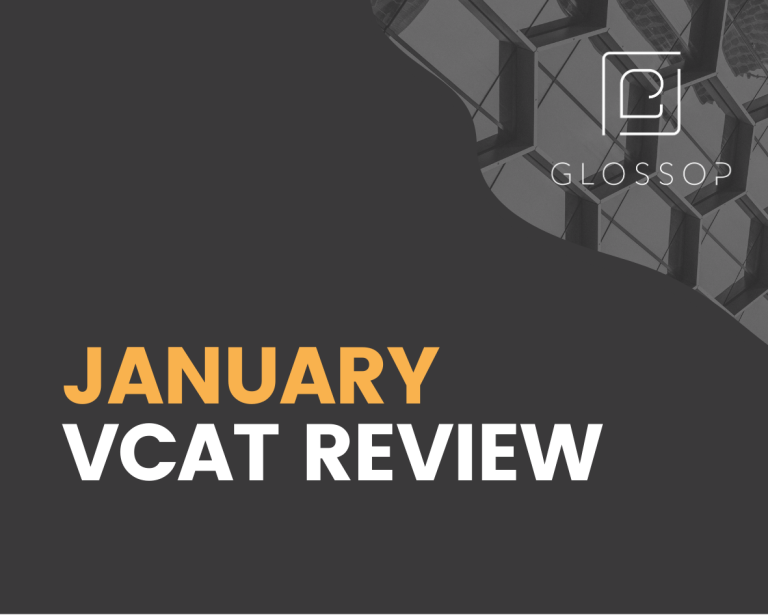To take a step back initially though, for 2024 by our counting of the reported decisions (i.e. not accounting for all appeals lodged, nor considering the nature/ complexity/ outcome of the matter), the top 5 metro Council’s by decision numbers were:
Yarra – 39
Stonnington – 29
Monash – 29
Melbourne – 28
Boroondara – 26
For the rural Councils, the top 5 were:
Greater Geelong – 16
Macedon Ranges – 16
Bass Coast – 15
Mitchell – 13
Baw Baw – 12
And a shout out to the 11 rural Councils who didn’t appear once in the decisions of 2024 having apparently being able to keep all stakeholders happy, no mean feat!
To return to January’s decisions, whilst undoubtedly each decision was of great interest to the relevant parties, two were of wider interest the first being Fellows v Bass Coast SC [2025] VCAT 43.
Fellows concerned an application for a single dwelling in Silverleaves on land subject to coastal inundation. Flooding is a ‘hot topic’ and Melbourne Water has often ‘led the charge’ in recent flooding decisions of note. In this matter, however, Melbourne Water did not object subject to conditions requiring floor levels to be above the projected 2100 inundation levels. In respect of this ‘no objection’ response from Melbourne Water, the Tribunal stated:
47. The applicant submits that the LSIO is primarily a referral trigger to secure the engagement of the floodplain management authority in its capacity as a determining referral authority. I do not accept this proposition.
48. It is true that in this application, Melbourne Water (MW) acting as the relevant water management authority, is a determining authority. It can object to the proposal and the responsible authority would then be bound to refuse the application on this basis. However this capacity does not usurp the expressed purposes of the LSIO, which relevant to this application are:
- A function to identify areas that are prone to flooding by coastal inundation at the one percent Annual Exceedance Probability (‘1% AEP’).
- Requiring the nature and extent of development to be managed to ensure flood damage is minimised and that development responds to the degree of flood hazard.
- Requiring development that minimises the potential flood risk to life, health and safety of those people associated with the development and which arises from the flood hazard.
49. The position of MW is one of many relevant matters to be considered under the decision guidelines, but the engagement of this authority is not an expressed purpose of the LSIO.
50. To the extent that the applicant’s proposition about this purpose could also be seen to elevate the position of MW above that of the responsible authority’s decision making role, this proposition is also not accepted.
51. Because MW has not objected, the responsible authority must exercise its discretion in deciding whether the LSIO’s purposes have been acceptably addressed and whether a permit should be issued. When exercising such a discretion it must consider a range of matters under the LSIO decision guidelines and clause 65.01 of the planning scheme. These matters include the response of MW (in this instance) but it also includes a range of other matters. The weight to be given to the relevant floodplain management authority’s advice is therefore a matter for the responsible authority, as it is now for me to consider in this proceeding.
The Tribunal had the benefit of expert evidence from an experienced hydrologist but ultimately declined to issue a permit principally based on a lack of safe access during a flood event stating:
110. To wade to refuge under the 2060 inundations scenario presents a scenario for a 1.2km walk through sections of flooded road. By 2100 it’s a wade along a 1.5km road network that is inundated to varying degrees and unsafe even for an adult at varying times. It is an unfair burden to place on future land owners or occupants to distinguish between these safe and unsafe conditions and make a reasoned decision about when it is safe to evacuate from the residence.
The second decision of interest was Carolbridge Pty Ltd v Yarra CC [2025] VCAT 83 which dealt with several questions of law argued by senior counsel regarding the discretion of decision making with respect to the relationship of the parent clause of an overlay and a schedule. At the risk of oversimplifying a detailed legal decision, the Tribunal found that the broad decision guidelines outlined within the head clause of an overlay do not allow for matters to be argued which are otherwise not considerations under the schedule. This is borne out in the Tribunal’s response to the first question posed being:
129. Question 1(a) is whether ‘impacts generated by wind associated with the proposed building’ are relevant.
130. The wind evidence to be relied on by the applicants expresses opinions on the results of a wind tunnel study which purports to predict the wind impacts of the proposed buildings and works on private land in and around the subject land. The applicants submit that ‘wind impacts arising from the design of the proposed building are unsafe for pedestrians in key open space locations proximate to [the subject land ie lot 1]’.
131. This wind evidence is not relevant to the purpose for which the discretion has been conferred ie to minimise impacts of new buildings and structures within the schedule 1 area (ie the Yarra (Birrarung) River Corridor) on the banks and waters of the Yarra River and public open space, pedestrian and bicycle paths that are ‘adjacent’ to those banks and waters.
132. Wind impacts on the specified private land are not related to impacts on the specified parts of the river corridor.
133. This conclusion also draws support from the fact that the schedule 1 decision guidelines do not expressly or impliedly refer to the need to consider wind impacts. The head clause decision guidelines also do not expressly refer this need. However, these guidelines include a need to consider ‘as appropriate … the provisions of any relevant policies and urban design guidelines’.
134. The applicants submit that there is a necessary implication because the UDG come within the description of that guideline, they refer to wind impacts and are referred to in the urban design policies and building design policies in the PPF.
135. The Council considered the UDG and wind impacts in making its decision, even though the need to consider urban design guidelines is not expressly required under the discretion to be exercised under the C2Z. The applicants submit that the Council’s consideration supports an implication of relevance under the DDO.
136. In these submissions the applicants fail to properly consider the importance of the head clause qualification that consideration is ‘as appropriate’ and that the policies and urban design guidelines must be ‘relevant’. Whether wind impacts are ‘appropriate’ or ‘relevant’ under the head clause decision guidelines is determined by purpose.
137. To the extent the applicants submit that a similar implication arises under the general decision guidelines, those submissions fail for similar reasons and for the reasons outlined by the Court in Viva Energy.
138. The applicants also submit that wind effects are a significant effect that the development may have on the environment and the PE Act requires those effects to be considered. It suffices to state that I agree with the observations of the Tribunal in Southern Grampians that this legislative obligation applies ‘in the context of the discretion being exercised’.
139. Accordingly, if the wind impacts are not relevant to purpose, they are not relevant as an effect on the environment. It is also unnecessary to consider whether the impacts referred to in the submissions and evidence could, as a matter of fact, be characterised as significant.
Please contact either Hew Gerrard (advocacy) or John Glossop (expert evidence) on (03) 9329 2288 or via email at mail@glossopco.com.au should our office be able to assist with any VCAT matters.


